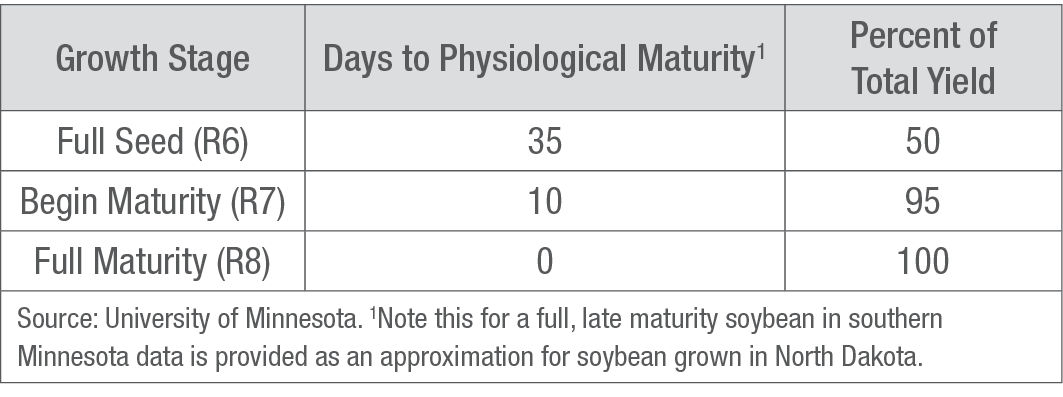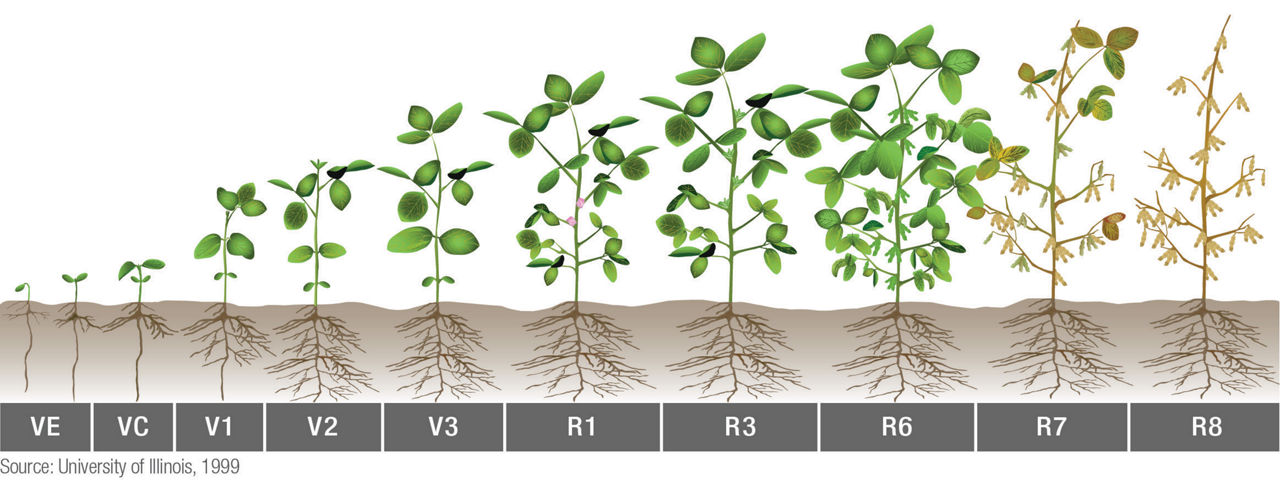5 MIN READ
Late Season Frost Damage to Soybean
November 13, 2023
KEY POINTS
- When a soybean crop suffers a light frost (30 °F to 32 °F) for a short period, the top leaves can be damaged along with small, late-maturing pods which may not fill properly or may even abort. Pods in the lower canopy are often protected and should fill normally.
- Soybean plant tissue (stems, pods, and leaves) can be damaged if exposed to frost, and the whole plant can be killed when temperatures drop below 30 °F for an extended period.
- The extent of the effect of a late-season frost on soybean grain quality is related to crop maturity and the amount of plant tissue killed.
- Yield losses due to frost are uncommon after soybean plants have reached full maturity (R8).
- Frost damage can vary across a field due to an occurrence know as cold air drainage or frost pockets, in which frost can cause more damage in low areas of the field due to the lower air temperatures in these areas when compared to higher areas of the field or areas where the field has a slope.
Introduction
The impact of a late-season frost on a soybean crop depends upon the growth stage of soybean plants when the frost occurs, temperatures, time of exposure, and cultural practices. Yield can be reduced when frost occurs at or before the R7 growth stage1. Frost temperatures that range from 30 °F to 32 °F can damage the top leaves of soybean plants; however, if air temperatures drop below 30 °F the entire plant may be killed. Generally, soybean plants in a narrow row spacing (15 inches or less) may tolerate a light frost better than plants in wider rows (30 inches and greater). A thicker soybean canopy can hold soil heat better and protect the developing lower pods, which can then continue to fill and develop normally after a frost. The amount of potential yield loss associated with an early frost is a combination of the loss of the number of beans per plant along with the potential for reduced seed size.1
Damage Caused to Soybean Plants by an Early Frost
If only the upper soybean leaves are damaged, the plants were probably not exposed to cold temperatures for an extended period. However, if leaves are damaged throughout the plant and close to the stem, cold exposure was likely more extensive and potential yield loss may be expected. The growth stage of soybean plants when frost occurred should be determined to evaluate the loss in yield potential (Table 1).1
Table 1. Days to maturity and percent yield produced at various maturity growth stages.

As soybean plants approach maturity, the risk for potential yield loss decreases.

Characteristics of Frost-Damaged Soybean
Characteristics that indicate a soybean plant was damaged by frost include:
- Immature green or elongated yellow soybeans that are shriveled and smaller in size than normal beans after drying.
- Difficulty extracting oil, which shows up as reduced extractable oil content (below 16 percent oil), and poor oil quality.
- Slower field drydown and actual crop moisture 1.5 to 2 percent higher than indicated by in-field moisture testers.2
- Soybeans that shatter at harvest and are harder to separate with the combine, which can result in higher foreign material (FM) in the grain.
Management
Other severe problems may arise when soybean plants are killed before reaching maturity, In addition to lower yield potential. These problems include some of the beans being an immature green color, lower oil-quality seeds, delayed maturity, lower grain quality, and variable moisture content. Frost-damaged soybean seeds are generally considered salvageable if the plants reached the R6 growth stage at the time of the frost-killing event. However, it is important to understand that not all pods mature evenly in a canopy. Varying maturities and varying plant locations within a field can lead to variable damage.
An early frost prior to maturity may also slow field dry down. If soybean plants need to be harvested with undesirably high moisture levels, immediately place the harvested beans in an on-farm bin with steady aeration for two to four weeks. This process can help reduce moisture levels and may begin to turn some of the green-colored beans to a normal mature color which will reduce discounts, especially if these beans are store for 40 to 60 days before being marketed. Frost-damaged soybean seeds placed in on-farm storage should be checked regularly for spoilage caused by high moisture content. Soybean seeds can also be dried in a grain dryer if drying temperatures are at 130 °F or lower.3
Sources
1 Kandel, H. 2020. Evaluating frost damage in soybean. North Dakota State University. Crop and Pest Report. https://www.ndsu.edu/agriculture/ag-hub/ag-topics/crop-production/crops/soybeans/evaluating-frost-damage-soybean
2 2015. Frost/freeze effects on corn and soybean. University of Nebraska – Lincoln. Institute of Agriculture and Natural Resources. https://cropwatch.unl.edu/frostfreeze-effects-corn-and-soybean
3 Hurburgh, C.R. and Benson, G.O. 2012. Frost damage to corn and soybeans. Iowa State University. Extension and Outreach. PM 1635 https://store.extension.iastate.edu/product/5140
Web sources verified 10/10/23. 1322_95717